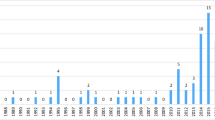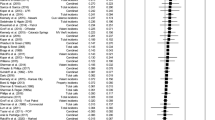Abstract
Situational crime prevention (SCP) measures are those that aim to prevent crime by reducing opportunities for offending and by increasing the effort and risk to offenders (Clarke, Building a safer society: Strategic approaches to crime prevention, 1995). There have been a number of systematic reviews, using the explicitly stated, transparent method adopted and documented by the Campbell Collaboration that focus on assessing the effectiveness of SCP interventions. In this chapter, we review the evidence arising from these reviews to assess whether general conclusions can be made about the effectiveness of situational approaches to the reduction and prevention of crime. In reviewing the evidence, we examine the individual effect sizes from all contributing studies as a single group. Our reason for taking this approach is that it allows us to examine the heterogeneity in evaluation effect sizes when assessing the broad effectiveness of SCP interventions and to see if there are any systematic patterns. We do this by classifying studies on a number of factors other than the type of situational measure employed. Analysis of the available reviews (there were seven that met our criteria) indicates that the mainstream situational measures such as closed-circuit television camera, improved lighting, and public area surveillance are effective at reducing crime, as are some of the situational strategies such as repeat victimization schemes and neighborhood watch. Our heterogeneity analysis revealed that other contextual factors, such as the time and place of implementation or the type of crime targeted, appear to be as important in explaining variation in effectiveness as the type of SCP employed.
Access this chapter
Tax calculation will be finalised at checkout
Purchases are for personal use only
Similar content being viewed by others
Notes
- 1.
http://www.campbellcollaboration.org/. Accessed 15 June 2012.
- 2.
http://www.popcenter.org/. Accessed 15 June 2012.
- 3.
The authors would like to thank David B. Wilson for a very helpful discussion on this issue.
- 4.
To be entirely accurate, it is in fact the cumulative number of effect size observations within the studies.
References
Bennett, T., Holloway, K., & Farrington, D. (2008). The effectiveness of neighborhood watch. Campbell Systematic Reviews, 4(18). http://campbellcollaboration.org/lib/project/50/.
Bowers, K. J., Johnson, S. D., & Hirschfield, A. F. G. (2004). The measurement of crime prevention intensity and its impact on levels of crime. British Journal of Criminology, 44(3), 1‑22.
Brantingham, P. L., & Brantingham, P. J. (1993). Environment, routine and situation: Toward a pattern theory of crime. Advances in Criminological Theory, 5, 259‑294.
Campbell, D. T., & Stanley, J. C. (1963). Experimental and quasi-experimental designs for research. Dallas: Houghton Mifflin.
Clarke, R. V. (1983). Situational crime prevention: Its theoretical basis and practical scope. Crime and Justice, 4, 225‑256.
Clarke, R. V. (1995). Situational crime prevention. In M. Tonry & D. P. Farrington (Eds.), Building a safer society: Strategic approaches to crime prevention. (Crime and justice: A review of research (Vol. 19). Chicago: University of Chicago Press.
Clarke, R. V., & Cornish, D. B. (1985). Modeling offenders’ decisions: A framework for research and policy. Crime and Justice, 6, 147‑185.
Clarke, R. V., & Newman, G. R. (2006). Outsmarting the terrorists. Westport: Praeger. Security International.
Clarke, R. V., & Weisburd, D. (1994). Diffusion of crime control benefits: Observations on the reverse of displacement. In R. V. Clarke (Ed.), Crime prevention studies (Vol. 2). Monsey: Criminal Justice Press.
Cornish, D. B., & Clarke. R. V. (2003). Opportunities, precipitators and criminal decisions: A reply to Wortley’s critique of situational crime prevention. In M. J. Smith & D. B. Cornish (Eds.), Theory for practice in situational crime prevention. Crime prevention studies (Vol. 16). Monsey: Criminal Justice Press.
Cohen, L. E., & Felson, M. (1979). Social change and crime rate trends: A routine activity approach. American Sociological Review, 44(4), 588‑608.
Ditter, S. M., Elder, R. W., Shults, R. A., Sleet, D. A., Compton, R., & Nichols, J. L. (2005). Effectiveness of designated driver programs for reducing alcohol-impaired driving: A systematic review. American Journal of Preventative Medicine, 28, 280‑287.
Eck, J. E. (1995). A general model of the geography of illicit retail marketplaces. In D. Weisburd & J. E. Eck (Eds.), Crime and place. (Crime Prevention Studies (Vol. 4.) Monsey: Criminal Justice Press.
Eck, J. E. (2006). Preventing crime at places. In L. W. Sherman, D. Farrington, B. Welsh, & D. MacKenzie (Eds.) Evidence-based crime prevention (revised ed.). New York: Routledge.
Farrington, D. P., & Welsh, B. C. (2004). Measuring the effects of improved street lighting on crime. British Journal of Criminology, 44(3), 448‑467.
Farrington, D. P., Gill, M., Waples, S. M., & Argomaniz, J. (2007). The effects of closed-circuit television (CCTV) on crime: Meta-analysis of an English national quasi-experimental multi-site evaluation. Journal of Experimental Criminology, 3(1), 21‑38.
Goldstein, H. (1979). Improving policing: A problem-oriented approach. Crime and Delinquency, 24, 236‑258.
Grove, L. E., Farrell, G., Farrington, D. P., & Johnson, S. D. (2012). Preventing repeat victimization: A systematic review. Report prepared for the Swedish National Council for Crime Prevention. Stockholm: The Swedish National Council for Crime Prevention.
Guerette, R. T. (2009). The pull, push and expansion of situational crime prevention evaluation: An appraisal of thirty-seven years of research. In N. Tilley & J. Knutsson (Eds.), Evaluating crime reduction initiatives. Crime prevention studies (Vol. 24, pp. 29‑58). Monsey: Criminal Justice Press.
Hesseling, R. (1994). Displacement: A review of the empirical literature. In R. V. Clarke (Ed.), Crime prevention studies (Vol. 3). Monsey: Criminal Justice Press.
Jeffery, C. R. (1971). Crime prevention through environmental design. Beverly Hills: Sage.
Johnson, S. D., & Bowers, K. J. (2003). Opportunity is in the eye of the beholder: The role of publicity in crime prevention. Criminology and Public Policy, 2, 497‑524.
Johnson, S. D., Bowers, K. J., & Guerette, R. (2011). Crime displacement and diffusion of benefit: A review of situational crime prevention measures. In B. Welsh & D. P. Farrington (Eds.), The Oxford handbook of crime prevention. Oxford: Oxford University Press.
Johnson, S. D., Bowers, K. J., & Hirschfield. A. (1997). New insights into the spatial and temporal distribution of repeat victimization. British Journal of Criminology, 37, 224‑241.
Knutsson, J., & Tilley, N. (Eds.). (2009). Evaluating crime reduction initiatives Crime prevention studies (Vol. 24). Monsey: Criminal Justice Press.
Lum, C., Kennedy, L. W., & Sherley, A. (2006) The effectiveness of counter-terrorism strategies. Campbell Systematic Reviews, 2(2). http://www.campbellcollaboration.org/lib/project/11/.
Merton, R. K. (1938). Social structure and anomie. American Sociological Review, 3(5), 672‑682.
Newman, O. (1972). Defensible space: Crime prevention through urban design. New York: Macmillan.
Pease, K. (1998). Repeat victimisation: Taking stock. Crime prevention and detection series paper 90. London: Home Office.
Pawson, R. (2006). Evidence-based policy: A realist perspective. London: Sage.
Pawson, R., & Tilley. N. (1997). Realistic evaluation. London: Sage.
Rengert, G. F., & Wasilchick, J. (2000). Suburban burglary: A tale of two suburbs. Springfield: Charles C. Thomas.
Shaw, C. R., & McKay, H. D. (1942). Juvenile delinquency in urban areas. Chicago: University of Chicago Press.
Smith, M. J., Clarke, R. V., & Pease, K. (2002). Anticipatory benefit in crime prevention. In N. Tilley (Ed.), Crime prevention studies (Vol. 13). Monsey: Criminal Justice Press.
Tilley, N. (1993). After Kirkholt: Theory, method and results of replication evaluations. London: Home Office.
Weisburd, D., Lum, C., & Petrosino, A. (2001). Does research design affect study outcomes in criminal justice? Annals of American Political and Social Science, 578, 50‑70.
Welsh, B. C., & Farrington, D. P. (2008a). Effects of improved street lighting on crime. Campbell Systematic Reviews, 4(13). http://www.campbellcollaboration.org/lib/project/45/.
Welsh, B. C., & Farrington, D. P. (2008b). Effects of closed circuit television surveillance on crime. Campbell Systematic Reviews, 4(17). http://www.campbellcollaboration.org/lib/project/49/.
Welsh B.C., Mudge M.E., Farrington D.P. (2010). Reconceptualizing public area surveillance and crime prevention: Security guards, place managers and defensible space. Security Journal, 23, 299‑319.
Welsh, B., Peel, M., Farrington, D., Elffers, H., & Braga, A. (2011). Research design influence on study outcomes in crime and justice: A partial replication with public area surveillance. Journal of Experimental Criminology, 7(2), 183‑198.
Yochelson, S., & Samenow, S. E. (1976). The criminal personality. Vol. 1: A profile for change. New York: Jason Aronson.
Author information
Authors and Affiliations
Corresponding author
Editor information
Editors and Affiliations
Rights and permissions
Copyright information
© 2016 Springer Science+Business Media New York
About this chapter
Cite this chapter
Bowers, K.J., Johnson, S.D. (2016). Situational Prevention. In: Weisburd, D., Farrington, D., Gill, C. (eds) What Works in Crime Prevention and Rehabilitation. Springer Series on Evidence-Based Crime Policy. Springer, New York, NY. https://doi.org/10.1007/978-1-4939-3477-5_4
Download citation
DOI: https://doi.org/10.1007/978-1-4939-3477-5_4
Published:
Publisher Name: Springer, New York, NY
Print ISBN: 978-1-4939-3475-1
Online ISBN: 978-1-4939-3477-5
eBook Packages: Law and CriminologyLaw and Criminology (R0)




